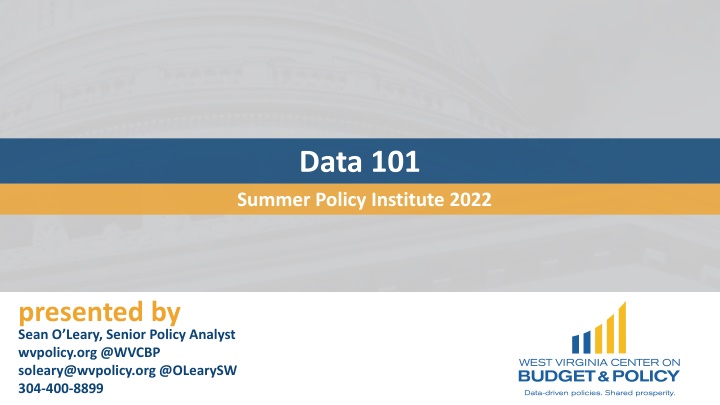
Understanding Unemployment: A Data Analysis Perspective
Dive into the intricacies of unemployment by exploring who is considered unemployed, the criteria for defining unemployment, and the importance of data analysis in policymaking. Discover valuable resources for economic data and learn how data can empower individuals to make informed decisions.
Download Presentation

Please find below an Image/Link to download the presentation.
The content on the website is provided AS IS for your information and personal use only. It may not be sold, licensed, or shared on other websites without obtaining consent from the author. If you encounter any issues during the download, it is possible that the publisher has removed the file from their server.
You are allowed to download the files provided on this website for personal or commercial use, subject to the condition that they are used lawfully. All files are the property of their respective owners.
The content on the website is provided AS IS for your information and personal use only. It may not be sold, licensed, or shared on other websites without obtaining consent from the author.
E N D
Presentation Transcript
Data 101 Summer Policy Institute 2022 presented by Sean O Leary, Senior Policy Analyst wvpolicy.org @WVCBP soleary@wvpolicy.org @OLearySW 304-400-8899
Data Exercise: What is Unemployment? Data Exercise: What is Unemployment? Who is counted as unemployed? Those not working? Receiving unemployment insurance? Laid off? Part-time workers who want more hours? unemployed? The unemployed unemployed are all members of the civilian labor force (by place of residence) who meet 3 criteria Lacked a job during the reference week Were available to work Made more than 1 active effort to find a job in the past 4 weeks The unemployment rate unemployment rate is the number of unemployed persons as a share of the civilian labor force
The Guiding Philosophy of Data Analysis The Guiding Philosophy of Data Analysis Using data to analyze policy is a powerful tool for understanding and improving the lives of our neighbors and our homes. Too many people are scared away by data, or they give data too much credit. Data are imperfect by nature, there is no one right answer to any question. Data analysis isn t necessarily about finding answers, but instead is a framework for organizing a complex world in ways we can understand. The power of data analysis is in the observer s ability to find meaning. Anyone who is curious and educated, and willing to learn basic data sources, concepts and techniques, can do it.
Resource Cheat Sheet Resource Cheat Sheet Data about economic output and production economic output and production (GDP, personal income and employment by industry). Bureau of Economic Analysis Regional Economic Accounts http://bea.gov/regional/index.htm Data about demographic traits of persons and businesses demographic traits of persons and businesses (population, age, poverty, education, household income). U.S. Census Bureau Data Explorer https://data.census.gov/cedsci/ Data about labor market information labor market information (employment, unemployment, hours, earnings). Bureau of Labor Statistics http://www.bls.gov/data/
Other Data Sources Other Data Sources U.S. Energy Information Administration (coal, natural gas production and prices). http://www.eia.gov/ Workforce WV (WV labor market information) http://lmi.workforcewv.org/ Census of State and Local Government Finance, NASBO (state budgets, taxes, and spending). https://www.census.gov/govs/local/ http://www.nasbo.org/
Shameless Self Promotion Shameless Self Promotion Your Guide to the WV State Budget https://wvpolicy.org/your-guide-to-the-state-budget-2/ Who Pays? Rethinking West Virginia s Tax System https://wvpolicy.org/who-pays-rethinking-west-virginias-tax-system/
Data Concepts: Absolute vs. Relative Data Data Concepts: Absolute vs. Relative Data Absolute Quantities: The total count of the number of times an item occurs (number of unemployed). Relative Quantities: The measure of one item in relation to another (unemployment rate). Ratios, rates, proportions, percentages, percentiles, indexes. Useful, but usually not enough for a proper analysis. Standardizes the value and enables comparisons Economic/social issues are interconnected, and context dependent. Usually a bad idea to use absolute values to make comparisons.
Data Concepts: Absolute vs. Relative Data Data Concepts: Absolute vs. Relative Data Kanawha County had a more people living in poverty than Cabell County in 2017 But Cabell County has a greater share of its population living in poverty 31,535 19.7% 17.9% 17,577 Kanawha County Cabell County Kanawha County Cabell County
Data Concepts: Growth and Change Data Concepts: Growth and Change Many data questions are about seeing how a something changes or grows over time. Growth and changes can be measured in different ways. Change can be measured in cross section or continuously. Comparing snapshots vs. watching a movie Change can be measured in absolute and relative terms. Again, relative is more useful percentage change
Data Concepts: Growth and Change Data Concepts: Growth and Change Changes in the number of employed persons between May 2012 and May 2019 in two labor markets: Huntington-Ashland, Metro Area: -6,361, falling from 144,145 to 137,784 Beckley, Metro Area: -3,615, falling from 47,612 to 43,997 Huntington had a larger absolute change in employment, but Beckley had a greater relative change. Huntington-Ashland: 4.4% decrease in employment Beckley: 7.6% decrease in employment On an annualized basis, Beckley had a faster growth (decline) rate. Huntington-Ashland: employment growth of -0.6% per year Beckley, WV: employment growth of -1.1% per year
Analysis Tips: Time Effects Analysis Tips: Time Effects Economic and social issues are effected by time. Data can be cross-sectional. Public data sources often provide snapshots at points of time, but are not tracking the same people over time. Many economic issues are subject to seasonality, or regular patterns that repeat over time. Labor variables have unadjusted and seasonally adjusted series. Employment in WV s retail sector fell by 2,800 jobs (-3.1%) from 12/16 to 1/17 before adjusting for seasonality and increased by 200 jobs (0.2%) after the seasonal adjustment. Labor markets are subject to the business cycle. Unemployment falls during expansions and rises in contractions. Nationally, the last contraction ran from 12/07 to 6/09; and the last expansion from 6/09 to 3/20.
Analysis Tips: Financial Values Analysis Tips: Financial Values Like other data, financial values can be expressed in absolute and relative terms. The average weekly wage construction wage in Barbour County in 2014Q4was $846.20; that equaled 76.6% of the statewide average Financial values are influenced by time. Prices of goods and services change both and aggregate and relative to each other (inflation/deflation). Financial values are therefore expressed as nominal (current/unadjusted for inflation) or real (constant/adjusted for inflation). The 1968 minimum wage of $1.60 would be worth $11.89 in 2020.
Questions to Ask: What is Analytical Problem? Questions to Ask: What is Analytical Problem? Most analysis can be attempts to address one of three problems. Problems of description (who is unemployed) Problems of evaluation (effects of an unemployment program) Problems of estimation (future changes in unemployment) The next step is to define key concepts and measures. Define unemployment, what data is being used? Four types of data measures: ratio (unemployment rate); interval (change in unemployment); ordinal (rankings); & nominal (gender). Use data is ideally both valid and reliable Valid data fairly measures the concept. Reliable data yields consistent measures over time
Questions to Ask: Data and tools Questions to Ask: Data and tools Which kinds of data are being used? Enumeration (count of every member of a population Decennial Census) Statistical sample (data from a representative subset of a population - American Community Survey) Administrative Records (data from program files) All public data is subject to errors. Which statistical tools are used? Descriptive statistics Central tendency measure that represents the average value in a group (mean, median, mode). Dispersion how much does the date cluster around a mean value (range, interquartile range, variance, standard deviation). Association measure patterns among variables (cross-tabulations are a useful way to show associations wages by race)
Questions to Ask: What is the Purpose of the Analysis? Questions to Ask: What is the Purpose of the Analysis? Usually, public officials look to data to help describe conditions in a particular region. How much has poverty grown in the past year? Sometimes the goal is to correlate different variable. Is there a relationship between educational attainment of workers and their wages (positive correlation)? Remember that correlation is not causation. Other times, the goal is to show is a change in one variable causes another one to change. Does a decrease in the duration of unemployment insurance cause workers to leave the labor force. This leads down the path of regression analysis.
You Are the Most Important Analytical Tool You Are the Most Important Analytical Tool The ability to find, use, and interpret data is not limited to experts. The best analysis is simply a framework for putting data into a form that people can grasp and understand. The goal is to understand our world so we can make rational and informed decisions.
Habits of Good Data Users Habits of Good Data Users ID what needs to be known and why. Think along regional lines Explore public data systems Brush up on basic math and statistics Make the best out of limited data Engage in the issue Remember the Public Good






















